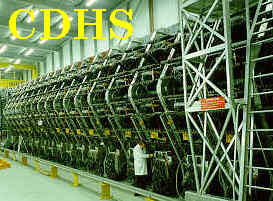DORTMUND
HEIDELBERG
SACLAY
WARSAW

| CERN
DORTMUND HEIDELBERG SACLAY WARSAW |
 |
The CDHS neutrino experiment at CERN
was a collaboration of CERN, Dortmund, Heidelberg and Saclay (later joined
by Warsaw) led by Jack
Steinberger. The experiment was designed to study deep inelastic neutrino
interactions in iron. The detector had a mass of 1250 tons and combined
the functions of a muon spectrometer and hadron calorimeter. It consisted
of 19 magnetized iron modules, separated from each other by wire drift
chambers.
The experiment took data in the CERN neutrino beams from December 1976
until 1984.
The main interactions studied were charged currents:
n + Fe --> m
+ anything
and neutral currents:
n + Fe --> n
+ anything
Later, a 31 m3 liquid hydrogen tank was placed in front
of the experiment to study neutrino interactions in hydrogen.
|
CDHS 1978 |
CDHS side view |
John Rander's cartoon |

Neutrino tomography |

Di-muon event from first publication |
An early publication |

Electroweak parameters |

Four-muon event |
A history of neutrino experiments can be found here.